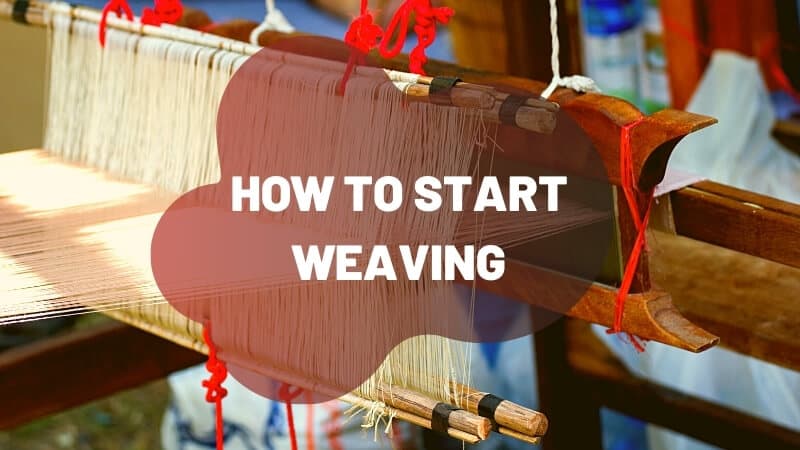How to Start Weaving – A Beginner’s Guide
Weaving is an ancient art that has been practiced for centuries. It’s a craft that can be done at home, and it’s relatively simple to do once you learn the basics. This beginner’s guide will teach you all about weaving: what it is, how to start weaving, and even some tips on how to avoid some common mistakes!
Let’s get started, then.
What is Weaving and How Does It Work?

Weaving is the process of hooking yarns, cloth, and thread together to create fabric. It’s an ancient craft that has been practiced for centuries around the world, in every region on Earth, from Africa to Asia.
Weaving can be done at home or professionally; it requires two arrangements: one with a set of shuttles (the weaving machine) and another with a coiled-up length of yarn called warping, which is looped over the loom poles.
The weaver utilizes these tools to weave different patterns into what will become their completed material – this process often includes wrapping threads around each other tightly, so they stay in place as you move them across your warp beam! The end result should resemble something like denim jeans or a nice bedsheet.
The weaver can choose between a variety of different patterns to weave, which will change the way their fabric is structured and how it looks in the end. Some of these include brocade (which creates intricate designs), twill (creates wavy parallel lines), or plain weaving (creates one even design). The type of texture that you want on your piece is an important decision!
People who are interested in starting this craft should make sure they have enough room for the loom as well as all necessary materials. A loom for weaving scarves will not require as much floor space as a bedsheet loom will.
Once everything has been gathered, you can start your project.
Weaving Jargons
You may have failed to understand some of the statements above if you’re a complete beginner. Don’t worry, though! We’ll explain all the weaving-related terminologies in this section to make it easy for you to grasp what we are saying.
Loom

A device that is used to hold the warps in a fixed position as they are manipulated by the weaver. There are two main types of looms, with four more variations within each type. They come in various sizes and shapes depending on what you want your finished product to be (e.g., if you’re weaving strips for rugs). Weaving can also take place with a rigid heddle or without one at all!
Wait a minute! What is a heddle?
Heddle
A rigid piece of material, often wooden slats or wire, is used to alternate the position and number of warp threads in a loom. It’s also known as a reed.
Warp
The horizontal threads of fabric run lengthwise along the loom; these threads pass over and under the wefts that are passed through them during the shedding motion.
Weft
The threads that are passed back and forth over the warp (lengthwise) to form a fabric are called weft, also known as woof or filling or pick. These are mainly responsible for the weaving pattern.
Shed
The space between two heddles, where the weft is woven on one side of the loom before passing onto another area for weaving. The motion is called shedding.
Primary Weaving Motions
The process of weaving in a loom consists of 3 fundamental movements, these movements ultimately define how does a loom work.
Shedding
When the weaver’s hand moves from one set of heddles to another, pulling up the warp threads on the first side and opening them for weaving.
Picking
When a shed is formed, you need to pass the weft through it. Generally, the pick is used to place the warp thread under or over a series of other threads on one side and then pass them behind or in front of those same threads on the opposite side.
Beating
When the pick or weft is inserted, the weaver needs to beat the threads in order to secure them and ensure that they have not been drawn too tight.
What Type of Loom Do You Need?
There are many different types of looms, but the most common is a floor loom. This type has two rows of heddles and a large front beam to guide the weft thread as it’s woven through an opening called a shed.
Other types include a table or bench looms (smaller) and hand-held looms called rigid heddle or warp extension looms. These smaller versions allow for more detailed patterns that require less space than larger models.
The easiest way to determine what you need is by how much room you have in your home—or if there even enough height clearance!
Floor Loom
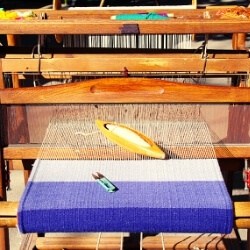
This type usually consists of two rows with three pairs of rods each, so there will be six “sheds” or spaces between the row of warp threads.
Table Loom
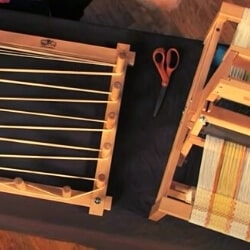
This type is usually smaller and can be set up on a table or bench in your home. It has one row with two pairs of rods, so there will only be four “sheds” between the rows of warp threads. You can get a table loom for beginners since it’s easy to operate.
Handheld Rigid Heddle Loom
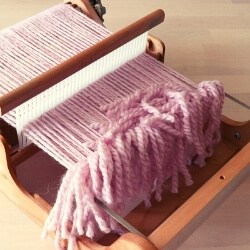
These are very small looms that use a rigid frame for weaving (instead of a large front beam) compared to floor or table models, which have an opening called a shed where the weft thread goes through from the backside to create patterns. There’s no need for height clearance because they’re portable!
Lap Loom
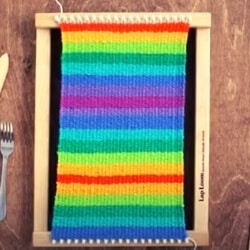
This type is a small loom that can be used in your lap. These are also widely used as the best weaving loom for beginners.
But What If I Don’t Want to Buy A Weaving Loom?
We understand, as a beginner, you might not be interested in investing in a loom. No worries! We got you covered. With some DIY magic, you can make one at the comfort of your home.
I will explain two methods. Depending on the availability of the material, you can choose either one.
Making Frame Loom Using a Wooden Frame: Looks Great
What You’ll Need:
A wooden frame, pencil, ruler, scissor, nails, drill or hammer, plier.
Step One: Mark the Edges
You’ll need to draw lines to identify the inside edges of your frame. You can use a ruler and pencil to do this.
Step Two: Mark the Nail Inserting Points Evenly
Now, you have to mark the points(along the length) where you’ll insert nails or tacks to attach the warp onto your frame. Distribute the points evenly, taking help from the ruler. The lower the gaps, the higher the density of your woven fabric. I prefer to keep 6mm gaps for my projects.
Step Three: Insert the Nails
After marking the point on both sides of the loom, now you have to insert the nails/tacks very carefully. Use a drill or hammer for this.
Step Four: Start Warping
You can now set up your warps and start weaving!
Making a Loom Using Cardboard: The Easiest Method
The easiest way to make a loom is by using cardboard. You can use any size, shape, or thickness, but the wider and thicker it is, the stronger your finished product will be.
What You’ll Need:
A piece of cardboard (any size), pencil, ruler, scissors.
Step One: Lay the piece of cardboard on a table or floor.
Step Two: Determine the direction you’re going to set-up your warp yarns.
Step Three: Now, we have to use our ruler and pencil to mark the points where we want our warps to be. Again, the gap depends on your preference, but I prefer a 1/4″ gap between my warps.
Note: It’s a good practice to start from the middle and then continue marking on both sides. Remember, your markings on both sides should align to make sure the warp remains perfectly straight and parallel to each other.
Step Four: Cut along your markings using a scissor. Cut a bit deep into the cardboard so that the warp stays secure. The depth should be equal for all the cuts.
Step Five: Here, take two pieces of cardboard strips and glue them just below your cut lines on both ends. These will make it easy for you to pass your weft yarn due to the extra space underneath the warp.
Step Six: Finally, you can set up your warp yarn and start weaving.
Additional Tools You’ll Need to Weave
Besides the loom, you’ll need the following tools to complete the primary shedding, picking, and beating motion:
- Shed stick (for shedding)
- Tapestry needle or shuttle (for picking)
- Tapestry beater (for beating)
How to Warp a Loom
Warping a handloom is relatively straightforward. For those just starting to weave, it’s best to stick with one color of warp threads and remember that the weft will be woven in every other thread along both sides. You can experiment by combining colors later on if you want!
Step One: Choose Your Warp
Pick the warp yarn of your liking. Tie a knot with any nail from any of the four corners.
Step Two: Wrap the Warp
Now, continue wrapping the yarn from one end to the other around the nails.
Step Three: Be Mindful of the Tension
Try to keep a constant tension so that it doesn’t become slack. Don’t worry if you can’t maintain a steady tension. You can adjust it later as well.
Step Four: Finish by Knotting Again
Once you have finished wrapping around all the nails, tie another knot with the last nail. You can adjust the tension again before tying this knot.
Step Five: Start Forming the Shed
Now, you have to use a shed stick or ruler. Pass it between the alternating row of yarns, keeping one yarn on top of the stick/ruler and the other one on the bottom.
Step Six: Use Two Sticks for Plain Weave
If you are using a ruler, then you’ll be able to see the shed as you go past each alternating yarn. And if you have used a ruler, you just need to turn it vertically so that the shed becomes apparent to you.
Pro Tip: I prefer to use two shed sticks for over-under patterns. Just like the above process, I pass another shed stick over and under the alternate yarns. Thus, I can take the help of the stick for shedding in both the over and under step.
Which Pattern is Best for a Beginner?
The plain weave.
It has an over-under pattern which is the easiest to form. It’s also the most widely used pattern. You just have to pass the warp thread through alternate warp threads (One Up-One Down)
Besides the plain weave, twill weave is also quite popular.
How to Finish a Weave?
The warp ends are tied off to the back of the loom. You can cut them off or leave a tail for darning in – it’s up to you what your preference is.
Common Mistakes People Make When They First Start Weaving
Here are some common mistakes people make when they first start weaving:
- Not being able to control the tension of a thread
- Knots and tangles that happen in the warp or weft threads.
- Too much pressure on your fingers while warping, which can lead to carpal tunnel syndrome if done for long periods at a time.
I’m not going into detail about how these issues are resolved because it would be too longwinded but feel free to ask me any questions you like!
Is Batting Necessary for Beginners to Learn Weaving?
When starting to learn weaving, beginners might question the need to use batting. However, using the best potholder batting options can provide insulation and protection for their hands while weaving. It also helps to create a more durable and quality finished product. So, yes, batting is necessary for beginners to learn weaving.
Final Words
Be creative! There are many ways to weave, and the only limit is your imagination, so go ahead and try different things.
I’m sorry if this article doesn’t cover everything you wanted to know about how to start weaving, but please don’t hesitate to contact me with any questions or requests for help.
REFERENCE:

